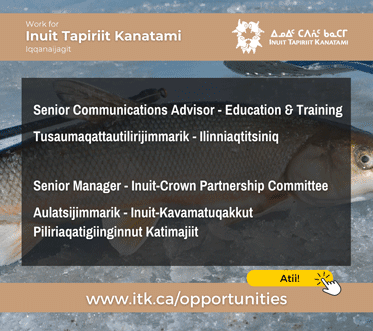Face to face, heart to heart
Iglulingmiut enjoy an electronic Christmas reunion.
MONTREAL — Iglulingmiut separated from each other by thousands of kilometres exchanged holiday greetings last week, thanks to the magic of long-distance videoconferencing.
Ottawa residents saw and spoke to family and friends in Igloolik last Thursday through a videoconferencing link between specially equipped rooms in Ottawa’s Museum of Nature and Igloolik’s Ataguttaaluk School.
Simeonie Kunuk, a long-term Ottawa resident, used the system to say hello to his relatives in Igloolik.
“We’re getting used to it,” Kunuk said. “We laugh, but in the beginning it was tough.”
That’s because it takes time get used to seeing loved ones on a 37-inch television screen.
And satellite-induced delay in the transmission of images and sound slows conversations.
But Kunuk said these get-togethers are getting smoother, as everyone becomes familiar with the technology – and as the technology itself improves.
Igloolik is linked via satellite to a telecommunications bridge in Yellowknife, where the signal is then sent back down to a southern network used by the Museum of Nature.
At least three public teleconferencing links between Ottawa and Igloolik are offered every year – at Christmas, Easter and September.
About 30 Iglulingmiut live in Ottawa, and many show up for the teleconference sessions.
“I’m from Igloolik. Of course, I can’t miss it,” said Melanie Paniaq, who went to the museum to communicate with her family.
Paniaq chatted with her daughter, mother, sister and little niece who found the whole experience confusing.
“She tried to touch the screen,” Paniak said.
Paniaq said everyone talked about the weather, and about how there’s no snow in Ottawa. In Igloolik, they showed her a frozen boot – to show just how cold it is there these days.
“They wished I were there for Christmas,” Paniaq said.
Some participants compared sewing patterns. Others got to see new babies for the first time.
At Christmas-time last year, Susan Arnatsiaq, who was in Igloolik, saw her baby, who was in Ottawa for medical treatment.
$1,300-a-month cost
Each two-hour teleconference session costs $550, although the monthly cost of maintaining the two sites is about $1,300. Both the federal and Nunavut governments help pay for the project.
“It is a luxury, but when you look at the cost of air travel, it’s not,” said project manager Carol Thiessen of the Museum of Nature.
The videoconferencing project is the result of a three-way partnership between the Inullariit Elders Society of Igloolik, the Museum of Nature, and Consilium, an Ottawa-based consulting firm.
Videoconferencing between Ottawa and Igloolik began in 1996 to test how the new technology could improve science and traditional knowledge education.
The first videoconferences took place between school children in Montreal and Iqaluit during the 1996 World Conservation Union Congress in Montreal.
A month-long series of videoconferences between Igloolik residents and visitors to the Museum of Nature’s exhibition, The Arctic Forever, then followed.
But the Inullariit Society wanted to continue using videoconferencing as an educational and development tool. Since 1996, the society has received museum-related training and help with its planning for a local museum and cultural centre.
The Smithsonian Institution also used the system to work with Iglulingmiut on an exhibit for the Museum of the North American Indian in Washington, D.C.
The current videoconference project also links up Igloolik and Ottawa-area students every month from October and March.
Last spring, students exchanged stories about what they did on their spring break.
For the Igloolik students, this included learning how to build igloos, an activity that they eagerly shared, via teleconferencing, with the interested Ottawa students.





(0) Comments